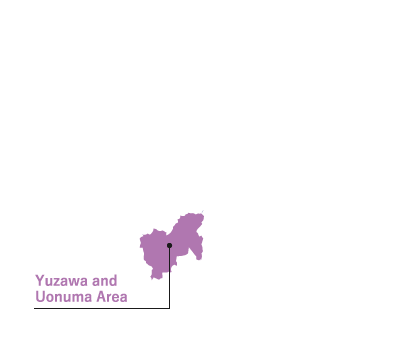
Trip to an Unexplored Region to Immerse in the Landscapes of Japan



1
The Hidden Border Akiyamago
-
Akiyamago refers to a village which spreads on the Nakatsugawa river, a branch of the Shinano river, is a gorge area that straddles Nagano and Niigata. Closed by the mountain surface and deep water, this area is a hidden boarder that still remains the traditional life style. In spring, it is surrounded by flowers of sargent's cherries and dogtooth violets, ray of sunshine comes through young leaves and you can hear the voice of wild birds. In fall, the joy of harvesting echoes into the golden gorge. Purely white snow that falls onto the rock surface enhance the hardness of winter and beauty of the gorge. It's also popular among tourists as its abundant nature as well as it history and culture which it took over from the old times.

2
Ryugakubo Pond
-
Ryugakubo Pond is a 1.2 hectare pond fed by a vast reserve of ancient groundwater. A remarkable 43,000 tons of water well up from the pond daily, replacing it all in a single day. Such abundant and pristine spring water is an unmatched rarity in the region.
With no nearby rivers, the area’s local water supply relies entirely on springs like Ryugakubo Pond. Its waters can be easily drunk from a tap just a minute’s walk from the parking lot. The area was designated a Nature Conservation Zone by Niigata Prefecture in 1974, and acknowledged as one of Japan’s 100 Best Waters in 1985.
Ryugakubo Pond is also rich with history and legend, and the two villages safeguarding it celebrate it with shrines and an annual festival in July.

3
Kiyotsu Gorge / Tunnel of Light
-
Kiyotsu Gorge stands among Japan's three great gorges, alongside Kurobe Gorge and Osugi Gorge. The towering cliffs creating a V-shaped grand canyon over the river are designated as a national scenic beauty and natural monument.
The stunning columnar-jointed rock surfaces and the dynamic landscapes along the Kiyotsu River are truly remarkable, leaving a lasting impression on visitors. Moreover, the entire tunnel was transformed into an artwork by the Chinese architectural firm Ma Yansong/MAD Architects during the 2018 Echigo-Tsumari Art Triennale.
Architectural spaces and artistic atmospheres inspired by the "five elements" of nature (wood, earth, metal, fire, and water) were crafted at various points inside the tunnel and at the entrance facility.
The entrance facility offers footbaths, merchandise sales, and a café (closed during winter).
Before planning your visit, please check the official website and X (formerly Twitter) for local conditions.

4
Matsudai Shibatouge Onsen "Unkai"
-
The high class hot spring, the landscape of the Uonuma mountain range, and the sea of clouds visible from the outer bath are the unique points of this inn. The hot spring is said to be effective for neuralgia, muscle pain, shoulder aches, blood circulation, cuts, burns, chronic skin disease, chronic gastrointestinal disease, fatigue, chronic women's diseases, and bruises.

10 minutes by car
5
NOHBUTAI Snow-Land Agrarian Culture Center, Matsudai
-
Themed around the "exchange between urban and rural areas," this comprehensive cultural facility uncovers and shares the region's abundant resources. A 2-km stretch of "satoyama" rural landscape, from Matsudai Nou-butai, the base facility, to Matsudai Castle atop the mountain, showcases approximately 40 art installations. Take a leisurely stroll to immerse yourself in the local nature and culture.
Designed by the Dutch architectural group MVRDV, Matsudai Nou-butai is not only a base facility but a work of art itself, featuring rooms designed by various artists. Explore the Matsudai Nou-butai Field Museum to tour these unique artworks, gaining insights into the satoyama landscape, the enduring farming culture of snow country, and the lifestyles of the local community. Whether on foot, by rented bicycle, or by car, you can explore the area based on the length of your stay and your specific interests.

6
Bijinbayashi Forest
-
Nestled on a 3-hectare hillside in Matsunoyama Matsuguchi, this beech forest boasts century-old trees that lend a unique beauty to the landscape. Known as the "Beautiful Forest," its name echoes the elegance of the standing trees. In the late Taisho era (1912-1926), the entire forest was felled for charcoal production, leaving the mountain bare. However, the following year witnessed a spectacular rebirth as beech trees sprouted and flourished, shaping the mountain's present appearance. This forest is also a thriving habitat for various wild birds.
Throughout the seasons, the beautiful beech forest unveils different expressions:
In spring, young leaves emerge against lingering snow, signaling the arrival of the season.
Summer invites you to experience a cool breeze amid vibrant greenery, with temperatures reportedly 2°C lower than the surrounding areas.
Autumn transforms the forest into a palette of yellows and oranges, enchanting visitors as if stepping into a living painting.
Winter blankets the area in a "silver world," where sunlight sparkles on the snow on sunny days.

7
Hoshitoge Rice Terraces
-
Spread across the slopes like fish scales, about 200 rice paddies of various sizes reveal different facets through the seasons and at different times of the day. During the peak season, when the sea of clouds graces the morning sky, and the water mirrors gleam brilliantly, photographers and tourists from across Japan flock to admire this stunning landscape. In addition to the mesmerizing sea of clouds, visitors can delight in the vibrant greenery of summer and the picturesque snowy terraced rice paddies in winter, crafting an enchanting snowy landscape. In 2022, the Minister of Agriculture, Forestry, and Fisheries recognized the area as part of Japan's "Tsunagu Rice Terraces Heritage."
* Snowfall is possible even in mid-November and late April. Please check road conditions before planning your visit.
* During the snow season (usually from around December), roads are not plowed, making car access impossible to appreciate the terraced rice fields.


























































